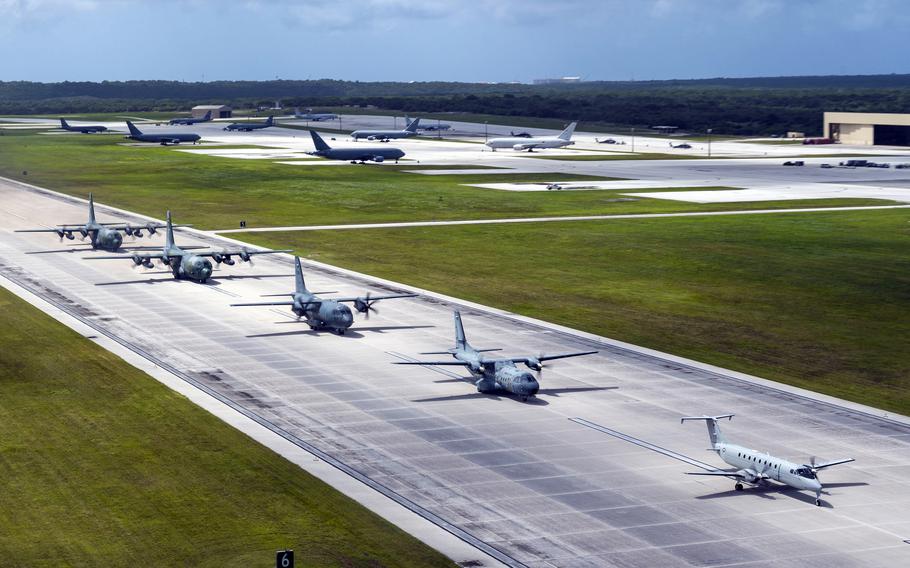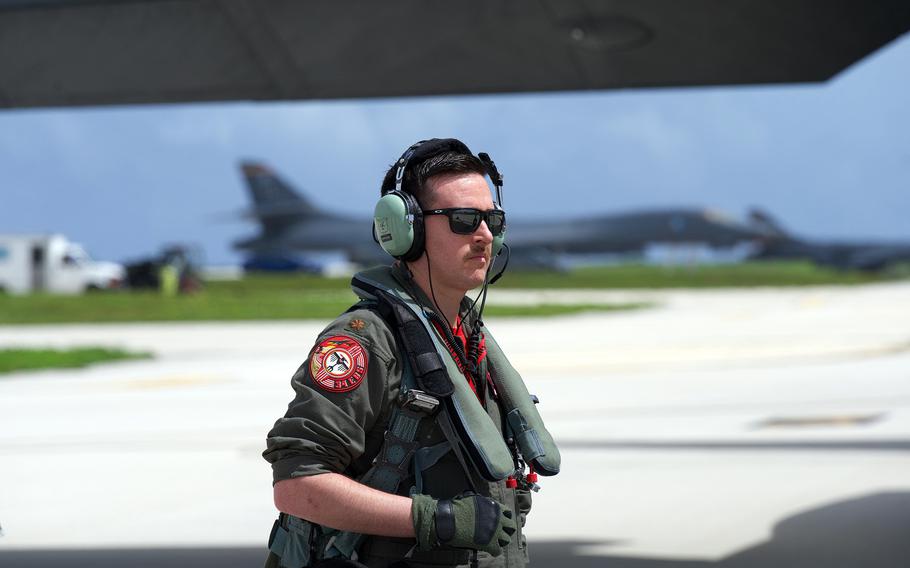
Aircraft from the United States, Japan and France conduct an elephant walk at Andersen Air Force Base, Guam, Feb. 9, 2023, ahead of the Cope North exercise. (Daniel Hernandez/U.S. Air Force)
Air Forces from the United States and three Pacific allies have fanned out across 1,200 miles of the Pacific Ocean in a test of their ability to operate far from large, well-appointed bases.
Cope North, an annual airpower exercise involving 2,000 service members from the U.S., Japan, Australia, and France, began Feb. 10 and run through Feb. 24.
Forces from all four nations are spread across 10 spots between the Japanese island of Iwo Jima, also called Iwo To, in the north and the Republic of Palau in the south, Air Force Col. Jared Pasley said by phone Wednesday.
The locations are in the so-called second island chain, according to Pasley, the director of U.S. forces participating in the exercise. The chain, which includes Guam, stretches along the eastern border of the Philippine Sea and forms a strategic line of defense for the U.S.
The exercise comes amid heightened tensions with Beijing, which has been investing heavily in its military. Chinese President Xi Jinping has stated his intention of reuniting the autonomous and democratic island of Taiwan, by force if necessary.
Last month, Gen. Michael Minihan, who as head of Air Mobility Command oversees the Air Force’s fleet of transport and refueling aircraft, warned his airmen to speed their preparations for a potential conflict, citing Xi’s aspirations and the possibility that Americans will not be paying attention until it is too late.

Air Force Maj. Abraham Moreland, a 34th Expeditionary Bomb Squadron pilot, waits to board a B-1B Lancer for a Cope North mission at Andersen Air Force Base, Guam, Feb. 10, 2023. (Michael Caggiano/U.S. Air Force)
The Defense Department, however, distanced itself from Minihan’s comments, according to a Jan. 29 report by airandspaceforces.com.
“The National Defense Strategy makes clear that China is the pacing challenge for the Department of Defense and our focus remains on working alongside allies and partners to preserve a peaceful, free and open Indo-Pacific,” the news site reported Pentagon spokesman Air Force Brig. Gen. Patrick Ryder as saying.
Agile combat
The skills being honed at Cope North are part of a doctrine called agile combat employment, Pasley said.
“The training is focused on contested operations against a state actor and really upping the challenge,” he said. “This is probably the most aggressive and challenging Cope North I’ve seen.”
The exercise involves Air Force, Navy and Marine Corps fighters, transports, refuelers, helicopters and airborne warning and control aircraft, along with Japanese fighters and refuelers and French and Australian transports.
Logistics is a vital part of distributed operations, Pasley said.
“It’s the logistics that really separates the professionals from the junior varsity,” he said, noting that it’s a simple matter to fly a plane to a remote location but more complicated to fuel, arm and maintain it there.
Cope North is building skills to generate forward airpower under duress, Pasley said.
“We are testing our commanders’ ability to make risk-informed decisions and execute the mission,” he said.
Royal Australian Air Force Capt. Robert Graham said the 105 Australians participating in the exercise are flying a C-27J Spartan transport from Guam to the islands of Rota, Tinian and Saipan.
Australian airmen are used to operating from remote locations in the South Pacific, Graham said.
“We need to understand how the U.S. operates their agile combat employment so we know how to work with you,” he said.
Parallel challenge
Airfields would be a prime target in a conflict with China, so being able to operate flexibly with backup personnel is critical to sustaining combat, according to Ralph Cossa, president emeritus of the Pacific Forum think tank in Hawaii.
China could face parallel challenges in a war, he said in an email Thursday.
“If the Chinese believe mainland bases will be a sanctuary, they will only have themselves to blame when it turns out not to be true,” he said. “I would assume, and I would assume the Chinese would assume, that staging bases on the Mainland involved in operations against Taiwan will be early targets.”
Distributed operations will probably be more important to the U.S. and its allies than to China in any conflict, said Ian Chong, an associate professor of political science at the National University of Singapore.
“US and allied assets, with the exception of those from Japan, South Korea, and the Philippines, are spread regionally and globally,” he said in an email Thursday. “That means a need to be able to deploy flexibly in response to a contingency in East Asia. If a contingency involves [China], then [Chinese] forces would likely seek ways to complicate, if not block access.”